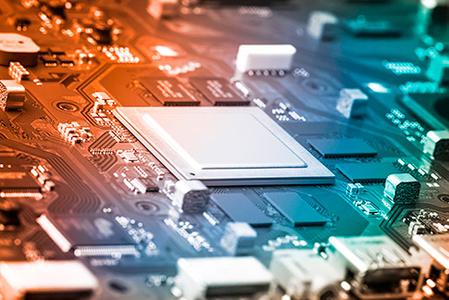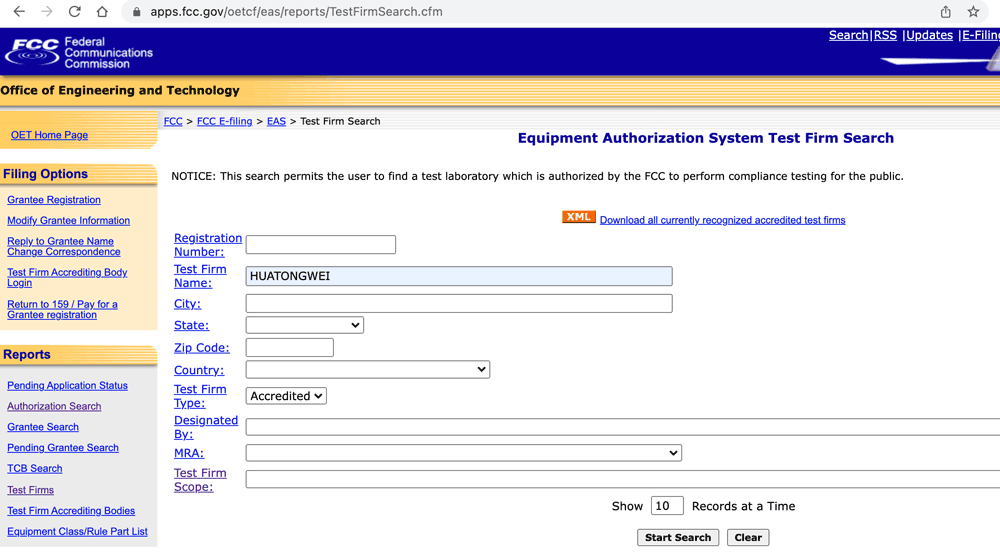FCC Certification

How to Get FCC Certification?
Send the product to an FCC-accredited lab for testing, such as our lab. We issue a test report after the product has been tested, and the TCB agency reviews and issues the certificate. At present, customers mainly adopt this method. FCC ID certification can be checked online in the United States to distinguish between true and false.
We will help you to obtain FCC certification in a short time and at low cost, which will help get your products to market faster, enabling greater sales and revenue potential overall. And we also provide CE Certification. For technical regulation support, technicians at HTW are able to help you understand technical regulations and product design specifications. Communicate with our experts to determine your needs and we will provide you with a free evaluation, proposal and quotation.
What is FCC Certification?
The United States has required standards for products that might contribute to electromagnetic interference in order to reduce the level of radio frequency (rf) interference between electronic devices. Any electronic device or piece of equipment that is sold in the United States must not compromise the safety of the American public or interfere with other electronic products.
The Federal Communications Commission (FCC) is in charge of the development, enforcement and implementation of regulations that Congress set forth in the Communications Act of 1934 and the Telecommunications Act of 1996. The FCC is an agency of the United States federal government that was created to regulate all forms of telecommunication inside of the U.S. including radio, television, digital cameras, Bluetooth, wireless devices and a broad gamut of RF electronics.
Manufacturers who wish to sell telecom, licensed RF, and low-powered transmitters in the United States must have their products tested by FCC listed or accredited lab and certified by the FCC for EMC/Telecom compliance.
When an electronic device has an FCC certificate, it means the product has been tested to comply with FCC standards and it has been approved. An FCC certification does not imply that the product is safe or durable. It simply means that it meets regulated limits for ionizing radiation. A certification does not imply that the device was manufactured any specific way. FCC approval can be granted as long as the electronic device meets FCC emission rules and regulations and has been tested to comply with FCC standards.
Email us if you have any questions or would like to consult an expert in our laboratory.
What is the Process for Obtaining a Certificate?
The FCC has three different processes under the EMC directive for administering certificate of compliances for electronic devices. The process for authorization is dependent upon device and type and power of rf emission. They will determine what method of screening your device will need to go through depending upon what type of device you’re trying to manufacture or distribute.
1. Verification (47 CFR Section 2.902)
Verification is the easiest method of authorization to pass in order to receive an FCC certificate. The verification process is used for digital products that are determined to have Part 15 components in order to obtain a part 15 certification. A device designated as Part 15 means the device either does not contain a radio or that it contains a radio that has already been approved. Part 15 devices only require verification; they do not need to receive approval and they do not need to bear a certified FCC logo.
2. Declaration of Conformity (DoC) (47 CFR Section 2.906)
A declaration of conformity (DoC) is the second easiest compliance process to go through in order to obtain an FCC certification. A DoC is used to test devices that contain or that are considered personal computers or peripherals of personal computers. Products that require DoC are considered Part 18 devices.
In order to receive Doc approval, FCC Part 18 devices must undergo testing in an accredited laboratory in order to measure the levels of radio frequency that are emitted from the product. Products that receive approval must show that they are in compliance with regulations by being stamped with the FCC logo.
3. Certification (47 CFR Section 2.907)
Certification is the hardest FCC approval process to achieve. The type of devices that require a certification have the potential to emit the highest amounts of radio frequency interference and cause the most harm to the public. A certification must be authorized and issued for radio frequency devices by an official Telecommunication Certification Body (TCB).
What Products Require an FCC Certificate?
Radio frequency (rf) equipment that is sold or distributed in the United States is required to undergo testing in order to stay in compliance with standards set by the Federal Communications Commission under the EMC directive. Testing limits both intentional and unintentional electromagnetic radiation that is emitted from rf equipment in order to keep users safe. HTW can help your company gain an FCC certificate for various types of rf emitting devices, including, but not limited to:

electronic products
mobile phones
wireless local area networking equipment
Bluetooth devices
remote control transmitters
land mobile radio transmitters
wireless medical telemetry transmitters
cordless telephones
walkie-talkies
electronic products
Power adapters
telecommunication equipment
IT equipment
electromagnetic compatibility products
equipment and protective systems intended for use in potentially explosive atmospheres
radio and telecommunications terminal equipment
Why Choose Us?
HTW Lab, accredited by CNAS, CMA, CNCA & A2LA, consistently operates competently and generates accurate and valid results in accordance with ISO/IEC 17025. We are also IECEE CB Scheme Test Laboratory (CBTL). Thus, testing reports from HTW Lab can be accepted between countries.
Your Benefits at a Glance:
1.20 Years of experience
HTW has extensive experience in all types of devices and regulatory requirements across markets.
2.Provide free modification service
Together with our wealth of knowledge in complex regulations globally, HTW provides a complete suite of testing solutions according to your needs including free modification service.
3.Save time to global markets
With over 7,000 square meters of labs, HTW offers the best testing cycles and you don't have to wait in line, HTW offers 1-on-1 service.With our in-depth insight of global product quality and regulatory requirements, HTW can optimize your costs and minimize your time to market.
4.Complete qualifications
ISO/IEC 17025 lab, accreditated by CNAS, CMA,A2LA,GLP.
5.Competitve price
Testing costs are lower than other labs.
Email:
If you’re a manufacturer or product distributor and you’re looking to get information about FCC electronics and rf compliance, email us.
Compliance testing and requirements set by the Federal Communications Commission can seem extremely confusing. They can cause major frustration for manufacturers and electronic distribution companies. We can help your company better understand the process needed to gain an FCC certificate and help your product become certified to be sold in the United States.
HTW Testing and Certification Solutions.
Step 1: Apply for Application
1. Fill in the application form (our company provides a blank template)
2. Provide product information "product instruction manual, schematic diagram, circuit diagram, block diagram, working principle and functional description, product BOM table (bill of materials)"
Step 2: Quotation (determine the test standard, test time and corresponding cost according to the provided information)
Step 3: payment and sample testing (after the applicant confirms the quotation, sign the "application form" and "service agreement" and pay the full project fee, and prepare the test sample.)
Step 4: Our company arranges the test
Step 5: After the test is passed and the report is completed, our company will submit the information to the FCC authorized certification agency for review.
Step 6: After the audit is completed, the TCB agency issues an FCC ID certificate, and the company can use the FCC mark on its products after obtaining the FCC certification.
1. FCC application form: the application company name, address, contact information, product name and model, usage standards and other information are required to be accurate;
2. FCC authorization letter: It must be signed and stamped by the contact person of the applicant company and scanned into an electronic file;
3. FCC confidentiality letter: The confidentiality letter is an agreement signed by the applicant company and the TCB organization on the confidentiality of product information, which must be signed and stamped by the contact person of the applicant company and scanned into an electronic file;
4. Block diagram: all crystal oscillators and crystal oscillator frequencies need to be drawn and kept consistent with the circuit diagram;
5. Circuit diagram: must be consistent with the crystal frequency, number of crystals and crystal position in the block diagram;
6. Line description: It is required to be in English, and clearly describe the functional realization principle of the product;
7. Instructions for use: FCC warnings are required;
8. Tag and tag location: The tag must have an FCC ID number and Statement, and the location of the tag must be significant;
9. Appearance photos inside the product: the pictures are required to be clear and clear, and remarks should be added when necessary;
10. Test report: The test is required to be completed, and the product is evaluated in an all-round way according to the standard terms;
Step 1 – Determine FCC Rules that Apply
Determine if device is a Radio Frequency (RF) device subject to the FCC rules.
Determine all applicable technical and administrative rules that apply to the device requiring an equipment authorization.
The technical requirements are generally specified in the applicable FCC rule parts and the administrative rules are specified in 47 CFR part 2, subpart J.
Step 2 – Equipment Authorization Procedures
If a device is subject to FCC rules, determine the specific type of equipment authorization that applies to the device. Become familiar with all the basic marketing, equipment authorization, and importation rules. In some instances, a device may have different functions resulting in the device being subject to more than one type of approval procedure.
Determine the applicable equipment authorization procedure for your device.
Supplier’s Declaration of Conformity (SDoC)/Certification
Step 3 – Compliance Testing
Perform the required tests to ensure the device complies with the applicable technical requirements (as determined in step 1).
The qualifications of the testing laboratory used to demonstrate compliance is based on the approval procedure you are required to use (as determined in step 2):
Supplier’s Declaration of Conformity (SDoC)
Equipment approved using SDoC is required to be tested, however, it is not necessary to use an FCC-recognized accredited testing laboratory. However, as minimum the testing laboratory used is required to maintain a record of the measurement facilities as specified in Section 2.948 and a record of the measurements made as specified in Section 2.938.
Certification
Equipment approved under the Certification procedure is required to be tested by an FCC-recognized accredited testing laboratory. [For a list of currently FCC-recognized accredited testing laboratory see https://apps.fcc.gov/oetcf/eas/reports/TestFirmSearch.cfm]
Step 4 – Approval
After the testing is complete and your device is found to be in compliance, finalize the approval process based on the applicable approval procedure:
Supplier’s Declaration of Conformity (SDoC)
The responsible party, as specified in the rules, warrants that each unit of equipment complies with the applicable FCC rules.
The responsible party maintains all of the required documentation demonstrating compliance with the applicable FCC rules.
The responsible party prepares a compliance information statement to be supplied with the product at the time of marketing.
Certification
The responsible party, typically the manufacturer, obtains an FCC Registration Number (FRN) for a device requiring Certification. The FRN is a 10-digit number used to identify the individual or organization doing business with the FCC. The same FRN will be used for future approvals.
After obtaining an FRN, the responsible party obtains a Grantee Code from the Commission by applying at the Grantee Registration website. A grantee code is required the first time a party applies for certification, and can be used for all future approvals.
The responsible party files with a Telecommunication Certification Body (TCB) an application for a grant of certification. An application for equipment authorization requires submission of information about the product, as listed in Section 2.1033. The applicant must submit the required information to a TCB for review as part of the certification process.
The TCB reviews all of the supporting information and the evaluation results to determine if the product complies with the FCC requirements. Once the TCB makes a decision to certify the product the supporting information is uploaded to the FCC Equipment Authorization Electronic System (EAS) – Database. A grant of certification is issued by the TCB on the FCC Equipment Authorization Electronic System (EAS) – Database.
Step 5 – Label/Manual/Record Retention
Label the product and provide the required customer information.
For more information see Labeling Guidelines – KDB Publication 784748.
Maintain all documentation as part of the responsibility for the retention of records and ensure that the manufactured products are in compliance. Section 2.938 – Requirements for the retention of records of equipment subject to FCC approval.
Step 6 – Manufacture/Import/Market
When importing products into the United States, follow the FCC importation requirements.
Importation – Frequently Asked Questions.
Marketing of radio frequency devices prior to equipment authorization.
NOTE – Determining all applicable technical and administrative rules requires a technical understanding of the electrical functions of the device and an understanding of the FCC rules. For assistance, we recommend that you work with one of the FCC recognized accredited testing laboratories or TCBs. Questions can also be submitted through the Knowledge Database (KDB).
Step 7 - Modifications to approved products
Changes to your product design may require an additional approval. KDB Publication 178919 gives general guidance when making changes to a previously approved product. See the permissive change rules in Section 2.1043 for:
Modifications that may be made to an RF device without filing for a new equipment authorization;
Three different types of permissive changes; and identifies when a permissive change filing with the Commission is required.
HTW Lab - Since 1980, specialise in IoT & wireless device testing. We work with you and grow your business. Kindly check our accreditation: ISO/IEC 17025 Accredited - CNAS: L1225; A2LA: 3902.01; FCC: 762235; IC: 5377A. In addition, login to FCC official website, find and click on 'Test Firm', search for 'HUATONGWEI' to see our cases on record (1655 Applications can be Found). Follow us on YouTube, you can find the step-by-step instruction - HTW Lab FCC Certification.


